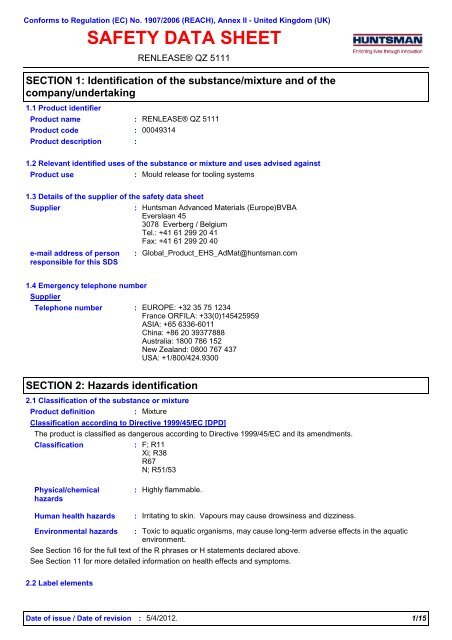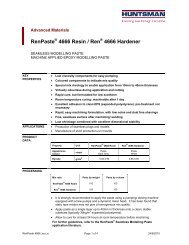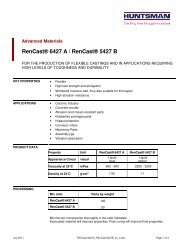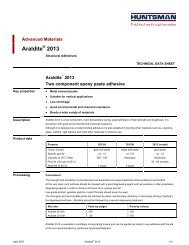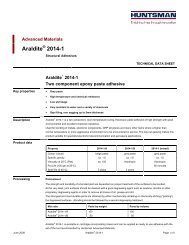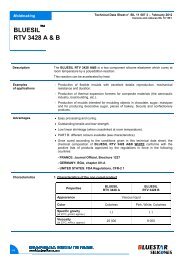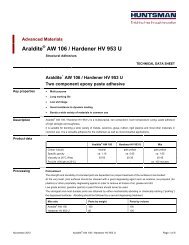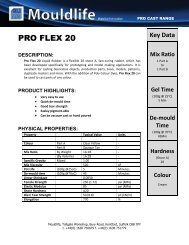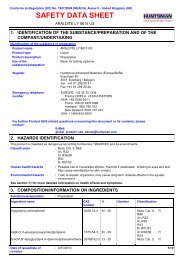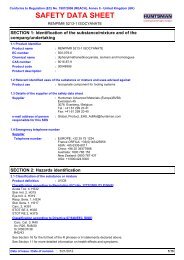8022 RENLEASE QZ 5111 (English (GB)) Huntsman ... - Mouldlife
8022 RENLEASE QZ 5111 (English (GB)) Huntsman ... - Mouldlife
8022 RENLEASE QZ 5111 (English (GB)) Huntsman ... - Mouldlife
You also want an ePaper? Increase the reach of your titles
YUMPU automatically turns print PDFs into web optimized ePapers that Google loves.
Conforms to Regulation (EC) No. 1907/2006 (REACH), Annex II - United Kingdom (UK)<strong>RENLEASE</strong> <strong>QZ</strong> <strong>5111</strong>Date of printing : 4 May 2012MSDS no.: 00049314Date of issue : 4 May 2012Version : 14/15SECTION 4: First aid measuresIngestion :Wash out mouth with water. Remove dentures if any. Remove victim to fresh airand keep at rest in a position comfortable for breathing. If material has beenswallowed and the exposed person is conscious, give small quantities of water todrink. Stop if the exposed person feels sick as vomiting may be dangerous. Do notinduce vomiting unless directed to do so by medical personnel. If vomiting occurs,the head should be kept low so that vomit does not enter the lungs. Get medicalattention if adverse health effects persist or are severe. Never give anything bymouth to an unconscious person. If unconscious, place in recovery position and getmedical attention immediately. Maintain an open airway. Loosen tight clothing suchas a collar, tie, belt or waistband.Protection of first-aiders: No action shall be taken involving any personal risk or without suitable training. Itmay be dangerous to the person providing aid to give mouth-to-mouth resuscitation.4.2 Most important symptoms and effects, both acute and delayedPotential acute health effectsEye contactInhalationSkin contactIngestion:May cause eye irritation.: Vapours may cause drowsiness and dizziness.: Irritating to skin.: Irritating to mouth, throat and stomach.Over-exposure signs/symptomsEye contact: No specific data.Inhalation: Adverse symptoms may include the following:nausea or vomitingheadachedrowsiness/fatiguedizziness/vertigoSkin contactIngestion::Adverse symptoms may include the following:irritationrednessNo specific data.4.3 Indication of any immediate medical attention and special treatment neededNotes to physician : Treat symptomatically. Contact poison treatment specialist immediately if largequantities have been ingested or inhaled.Specific treatments : Symptomatic treatment and supportive therapy as indicated. Following severeexposure the patient should be kept under medical review for at least 48 hours.SECTION 5: Firefighting measures5.1 Extinguishing mediaSuitable extinguishingmediaUnsuitable extinguishingmedia::Use dry chemical, CO2, water spray (fog) or foam.Do not use water jet.5.2 Special hazards arising from the substance or mixtureHazards from thesubstance or mixtureHazardous thermaldecomposition products::Highly flammable liquid. In a fire or if heated, a pressure increase will occur and thecontainer may burst, with the risk of a subsequent explosion. Runoff to sewer maycreate fire or explosion hazard.Decomposition products may include the following materials:carbon dioxidecarbon monoxideDate of issue / Date of revision : 5/4/2012.4/15
Conforms to Regulation (EC) No. 1907/2006 (REACH), Annex II - United Kingdom (UK)<strong>RENLEASE</strong> <strong>QZ</strong> <strong>5111</strong>Date of printing : 4 May 2012MSDS no.: 00049314Date of issue : 4 May 2012Version : 16/15SECTION 7: Handling and storageThe information in this section contains generic advice and guidance. The list of Identified Uses in Section 1 should beconsulted for any available use-specific information provided in the Exposure Scenario(s).7.1 Precautions for safe handlingProtective measures : Put on appropriate personal protective equipment (see Section 8). Do not ingest.Avoid contact with eyes, skin and clothing. Avoid breathing vapour or mist. Avoidrelease to the environment. Refer to special instructions/safety data sheet. Use onlywith adequate ventilation. Wear appropriate respirator when ventilation isinadequate. Do not enter storage areas and confined spaces unless adequatelyventilated. Keep in the original container or an approved alternative made from acompatible material, kept tightly closed when not in use. Store and use away fromheat, sparks, open flame or any other ignition source. Use explosion-proof electrical(ventilating, lighting and material handling) equipment. Use non-sparking tools.Take precautionary measures against electrostatic discharges. To avoid fire orexplosion, dissipate static electricity during transfer by earthing and bondingcontainers and equipment before transferring material. Empty containers retainproduct residue and can be hazardous. Do not reuse container.Advice on generaloccupational hygiene:Eating, drinking and smoking should be prohibited in areas where this material ishandled, stored and processed. Workers should wash hands and face beforeeating, drinking and smoking. Remove contaminated clothing and protectiveequipment before entering eating areas. See also Section 8 for additionalinformation on hygiene measures.7.2 Conditions for safestorage, including anyincompatibilities:Store between the following temperatures: 2 to 40°C (35.6 to 104°F). Store inaccordance with local regulations. Store in a segregated and approved area. Storein original container protected from direct sunlight in a dry, cool and well-ventilatedarea, away from incompatible materials (see section 10) and food and drink.Eliminate all ignition sources. Separate from oxidizing materials. Keep containertightly closed and sealed until ready for use. Containers that have been openedmust be carefully resealed and kept upright to prevent leakage. Do not store inunlabelled containers. Use appropriate containment to avoid environmentalcontamination.Storage hazard class<strong>Huntsman</strong> AdvancedMaterials: Storage class 3, Flammable liquids7.3 Specific end use(s)Recommendations :Industrial sector specific :solutionsNot available.Not available.SECTION 8: Exposure controls/personal protectionThe information in this section contains generic advice and guidance. The list of Identified Uses in Section 1 should beconsulted for any available use-specific information provided in the Exposure Scenario(s).8.1 Control parametersOccupational exposure limitsDate of issue / Date of revision : 5/4/2012.6/15
Conforms to Regulation (EC) No. 1907/2006 (REACH), Annex II - United Kingdom (UK)<strong>RENLEASE</strong> <strong>QZ</strong> <strong>5111</strong>Date of printing : 4 May 2012MSDS no.: 00049314Date of issue : 4 May 2012Version : 17/15SECTION 8: Exposure controls/personal protectionProduct/ingredient nameExposure limit valuescyclohexane EH40/2005 WELs (United Kingdom (UK), 8/2007).STEL: 1050 mg/m³ 15 minute(s).STEL: 300 ppm 15 minute(s).TWA: 100 ppm 8 hour(s).TWA: 350 mg/m³ 8 hour(s).n-hexane EH40/2005 WELs (United Kingdom (UK), 8/2007).TWA: 72 mg/m³ 8 hour(s).TWA: 20 ppm 8 hour(s).Recommended monitoringproceduresDerived effect levelsNo DELs available.:If this product contains ingredients with exposure limits, personal, workplaceatmosphere or biological monitoring may be required to determine the effectivenessof the ventilation or other control measures and/or the necessity to use respiratoryprotective equipment. Reference should be made to European Standard EN 689 formethods for the assessment of exposure by inhalation to chemical agents andnational guidance documents for methods for the determination of hazardoussubstances.Predicted effect concentrationsNo PECs available.8.2 Exposure controlsAppropriate engineeringcontrolsIndividual protection measuresHygiene measures :Eye/face protectionSkin protectionHand protectionMaterial of gloves forlong term application(BTT>480min):Material of gloves forshort term/splashapplication(10min
Conforms to Regulation (EC) No. 1907/2006 (REACH), Annex II - United Kingdom (UK)<strong>RENLEASE</strong> <strong>QZ</strong> <strong>5111</strong>Date of printing :Date of issue :4 May 20124 May 2012MSDS no.SECTION 8: Exposure controls/personal protectionBody protection :Other skin protectionRespiratory protection :Environmental exposurecontrolsPhysical stateColourOdourOdour thresholdpHMelting point/freezing pointInitial boiling point and boilingrangeFlash pointEvaporation rateUpper/lower flammability orexplosive limitsVapour pressureVapour densityRelative densitySolubility(ies)Water solubility :Partition coefficient: n-octanol/water (LogKow):Version :: 00049314Personal protective equipment for the body should be selected based on the taskbeing performed and the risks involved and should be approved by a specialistbefore handling this product.Appropriate footwear and any additional skin protection measures should beselected based on the task being performed and the risks involved and should beapproved by a specialist before handling this product.In case of inadequate ventilation wear respiratory protection. Respirator selectionmust be based on known or anticipated exposure levels, the hazards of the productand the safe working limits of the selected respirator.: Emissions from ventilation or work process equipment should be checked to ensurethey comply with the requirements of environmental protection legislation. In somecases, fume scrubbers, filters or engineering modifications to the processequipment will be necessary to reduce emissions to acceptable levels.SECTION 9: Physical and chemical properties9.1 Information on basic physical and chemical propertiesAppearanceFlammability (solid, gas)Burning timeBurning rateLiquid. [Emulsion.]Not available.of solventNot available.Not available.Not available.84°CClosed cup: -9°C [PMCC]Not available.7.5 kPa [20°C]Not available.Not available.20 deg CNot available.Auto-ignition temperature : 250°CDecomposition temperature : Not available.Viscosity: Dynamic: 5 mPa·sExplosive properties: Not available.Oxidising properties : Not available.:::::::::: Not available.: Not applicable.: Not applicable.: Lower: 0.8%Upper: 6.5%::::practically insoluble18/159.2 Other informationDensity: 0.71 g/cm 3 [20°C (68°F)]Date of issue / Date of revision : 5/4/2012.8/15
Conforms to Regulation (EC) No. 1907/2006 (REACH), Annex II - United Kingdom (UK)<strong>RENLEASE</strong> <strong>QZ</strong> <strong>5111</strong>9/15Date of printing : 4 May 2012MSDS no.: 00049314Date of issue : 4 May 2012Version : 1SECTION 10: Stability and reactivity10.1 Reactivity : No specific test data related to reactivity available for this product or its ingredients.10.2 Chemical stability :The product is stable.10.3 Possibility ofhazardous reactions: Under normal conditions of storage and use, hazardous reactions will not occur.10.4 Conditions to avoid : Avoid all possible sources of ignition (spark or flame). Do not pressurise, cut, weld,braze, solder, drill, grind or expose containers to heat or sources of ignition.10.5 Incompatible materials :Reactive or incompatible with the following materials: oxidizing materials and acids.strong bases10.6 Hazardousdecomposition productsSECTION 11: Toxicological information11.1 Information on toxicological effectsAcute toxicityPotential acute health effectsInhalation:Under normal conditions of storage and use, hazardous decomposition productsshould not be produced.Decomposition products may include the following materials:Carbon oxides, Burningproduces obnoxious and toxic fumes.Product/ingredient name Endpoint Species Result Exposurecyclohexane LD50 Dermal Rabbit >2000 mg/kg -LD50 Oral Rat 5500 to 6000 -mg/kgn-hexane LC50 Inhalation Vapour Rat 135 to 169 mg/L 4 hoursLD50 Oral Rat 25000 to 32400mg/kg-Irritation/CorrosionConclusion/SummarySkin :Eyes :Respiratory :SensitiserConclusion/SummaryMutagenicityProduct/ingredient name Test Resultn-hexane - NegativeCarcinogenicityReproductive toxicityProduct/ingredient name Test Species Result/Result type Targetorgansn-hexane - Rat Inhalation -TeratogenicityInformation on the likelyroutes of exposure: No additional information.:No additional information.No additional information.No additional information.Not available.: Vapours may cause drowsiness and dizziness.Date of issue / Date of revision : 5/4/2012.9/15
Conforms to Regulation (EC) No. 1907/2006 (REACH), Annex II - United Kingdom (UK)<strong>RENLEASE</strong> <strong>QZ</strong> <strong>5111</strong>Date of printing : 4 May 2012MSDS no.: 00049314Date of issue : 4 May 2012Version : 110/15SECTION 11: Toxicological informationIngestionSkin contactEye contactPotential chronic health effects:Irritating to mouth, throat and stomach.: Irritating to skin.: May cause eye irritation.Symptoms related to the physical, chemical and toxicological characteristicsInhalation: Adverse symptoms may include the following:nausea or vomitingheadachedrowsiness/fatiguedizziness/vertigoIngestionSkin contactEye contact::No specific data.Adverse symptoms may include the following:irritationredness: No specific data.Delayed and immediate effects and also chronic effects from short and long term exposureShort term exposurePotential immediateeffectsPotential delayed effects :Long term exposurePotential immediateeffectsPotential delayed effects :::Not available.Not available.Not available.Not available.Conclusion/Summary : Not available.General : No known significant effects or critical hazards.Carcinogenicity : No known significant effects or critical hazards.Mutagenicity : No known significant effects or critical hazards.Teratogenicity : No known significant effects or critical hazards.Developmental effects : No known significant effects or critical hazards.Fertility effects: No known significant effects or critical hazards.Other information : Not available.SECTION 12: Ecological information12.1 ToxicityProduct/ingredient name TestEndpoint Exposure Species Resultn-hexane - Acute EC50 48 hours Daphnia 3.88 mg/L12.2 Persistence and degradability12.3 Bioaccumulative potentialProduct/ingredient name LogPow BCF Potentialn-hexane 3.9 to 4.11 - high12.4 Mobility in soilSoil/water partitioncoefficient (KOC)Mobility::Not available.Not available.Date of issue / Date of revision : 5/4/2012.10/15
Conforms to Regulation (EC) No. 1907/2006 (REACH), Annex II - United Kingdom (UK)<strong>RENLEASE</strong> <strong>QZ</strong> <strong>5111</strong>Date of printing : 4 May 2012MSDS no.: 00049314Date of issue : 4 May 2012Version : 111/15SECTION 12: Ecological information12.5 Results of PBT and vPvB assessmentNot applicable.12.6 Other adverse effects : No known significant effects or critical hazards.12.7 Other ecological informationSECTION 13: Disposal considerationsThe information in this section contains generic advice and guidance. The list of Identified Uses in Section 1 should beconsulted for any available use-specific information provided in the Exposure Scenario(s).13.1 Waste treatment methodsProductMethods of disposal :The generation of waste should be avoided or minimised wherever possible.Significant quantities of waste product residues should not be disposed of via thefoul sewer but processed in a suitable effluent treatment plant. Dispose of surplusand non-recyclable products via a licensed waste disposal contractor. Disposal ofthis product, solutions and any by-products should at all times comply with therequirements of environmental protection and waste disposal legislation and anyregional local authority requirements. Waste packaging should be recycled.Incineration or landfill should only be considered when recycling is not feasible. Thismaterial and its container must be disposed of in a safe way. Care should be takenwhen handling emptied containers that have not been cleaned or rinsed out. Emptycontainers or liners may retain some product residues. Vapor from product residuesmay create a highly flammable or explosive atmosphere inside the container. Do notcut, weld or grind used containers unless they have been cleaned thoroughlyinternally. Avoid dispersal of spilt material and runoff and contact with soil,waterways, drains and sewers.Hazardous waste : Yes.European waste catalogue (EWC)Waste codeWaste designation07 02 04* other organic solvents, washing liquids and mother liquorsPackagingMethods of disposal :Special precautions :The generation of waste should be avoided or minimised wherever possible. Wastepackaging should be recycled. Incineration or landfill should only be consideredwhen recycling is not feasible.This material and its container must be disposed of in a safe way. Care should betaken when handling emptied containers that have not been cleaned or rinsed out.Empty containers or liners may retain some product residues. Vapor from productresidues may create a highly flammable or explosive atmosphere inside thecontainer. Do not cut, weld or grind used containers unless they have been cleanedthoroughly internally. Avoid dispersal of spilt material and runoff and contact withsoil, waterways, drains and sewers.SECTION 14: Transport information14.1 UN number 14.2 UN proper shipping nameADR/RIDIMDGUN1993UN1993Flammable liquid, n.o.s. NAPHTA, HYDROTREATED LIGHT AND HEXANE,MIXTURE OF ISOMERS (MAX. 5% N-HEXANE)Flammable liquid, n.o.s. (NAPHTA, HYDROTREATED LIGHT AND HEXANE,MIXTURE OF ISOMERS (MAX. 5% N-HEXANE)).Marine pollutant (naphtha (petroleum), hydrogen treated, light, contains
Conforms to Regulation (EC) No. 1907/2006 (REACH), Annex II - United Kingdom (UK)<strong>RENLEASE</strong> <strong>QZ</strong> <strong>5111</strong>Date of printing : 4 May 2012MSDS no.: 00049314Date of issue : 4 May 2012Version : 112/15SECTION 14: Transport informationIATAUN1993Flammable liquid, n.o.s. (NAPHTA, HYDROTREATED LIGHT AND HEXANE,MIXTURE OF ISOMERS (MAX. 5% N-HEXANE))14.3 Transporthazard class(es)14.4 Packinggroup14.5Environmentalhazards14.6 Specialprecautions foruserAdditionalinformationADR/RID3 IIYes.Not available.Hazardidentificationnumber33Specialprovisions601 274 640DTunnel codeD/EIMDG3 IIYes.Not available.Emergencyschedules (EmS)F-E, _S-E_IATA3 IIYes.Not available.Passenger andCargo AircraftQuantity limitation:5 LPackaginginstructions: 353Cargo AircraftOnlyQuantitylimitation: 60 LPackaginginstructions: 36414.7 Transport in bulkaccording to Annex II ofMARPOL 73/78 and the IBCCode: Not applicable.SECTION 15: Regulatory information15.1 Safety, health and environmental regulations/legislation specific for the substance or mixtureEU Regulation (EC) No. 1907/2006 (REACH)Annex XIV - List of substances subject to authorisationSubstances of very high concernNone of the components are listed.Annex XVII - Restrictionson the manufacture,placing on the market anduse of certain dangeroussubstances, mixtures andarticlesOther EU regulations:Not applicable.Date of issue / Date of revision : 5/4/2012.12/15
Conforms to Regulation (EC) No. 1907/2006 (REACH), Annex II - United Kingdom (UK)<strong>RENLEASE</strong> <strong>QZ</strong> <strong>5111</strong>Date of printing :Date of issue :4 May 20124 May 2012SECTION 15: Regulatory informationEurope inventoryBlack List ChemicalsPriority List ChemicalsIntegrated pollutionprevention and controllist (IPPC) - AirIntegrated pollutionprevention and controllist (IPPC) - WaterMSDS no.: All components are listed or exempted.: Not listed: Listed: Not listed: Not listedVersion :: 00049314113/15Product/ingredient nameCarcinogeniceffectsMutagenic effectsDevelopmentaleffectsFertility effectsn-hexane - - - Repr. Cat. 3; R62National regulationsReferencesInternational regulationsChemical WeaponsConvention List Schedule IChemicalsChemical WeaponsConvention List Schedule IIChemicalsChemical WeaponsConvention List Schedule IIIChemicals: The provision of Safety Data Sheets comes under Regulation 6 of CHIP (CHIP is therecognised abbreviation for the Chemicals Hazard Information and PackagingRegulations). This is an addition to the Health and Safety at Work Act 1974.: Not listed: Not listed: Not listed15.2 Chemical SafetyAssessmentSECTION 16: Other information:This product contains substances for which Chemical Safety Assessments are stillrequired.Indicates information that has changed from previously issued version.Abbreviations andacronyms: ATE = Acute Toxicity EstimateCLP = Classification, Labelling and Packaging Regulation [Regulation (EC) No.1272/2008]DNEL = Derived No Effect LevelEUH statement = CLP-specific Hazard statementPNEC = Predicted No Effect ConcentrationRRN = REACH Registration NumberClassification according to Regulation (EC) No. 1272/2008 [CLP/GHS]Flam. Liq. 2, H225Skin Irrit. 2, H315Repr. 2, H361fSTOT SE 3, H336Aquatic Chronic 2, H411Procedure used to derive the classification according to Regulation (EC) No. 1272/2008 [CLP/GHS]Flam. Liq. 2, H225Skin Irrit. 2, H315Repr. 2, H361fSTOT SE 3, H336Aquatic Chronic 2, H411ClassificationOn basis of test dataCalculation methodCalculation methodCalculation methodCalculation methodJustificationDate of issue / Date of revision : 5/4/2012.13/15
Conforms to Regulation (EC) No. 1907/2006 (REACH), Annex II - United Kingdom (UK)<strong>RENLEASE</strong> <strong>QZ</strong> <strong>5111</strong>Date of printing :Date of issue :4 May 20124 May 2012SECTION 16: Other informationFull text of abbreviated HstatementsFull text of classifications[CLP/GHS]Full text of abbreviated RphrasesFull text of classifications[DSD/DPD]Date of printingDate of issue/ Date ofrevisionDate of previous issueVersionNotice to reader::::::::H225H304H315H336H361fH373iH400H410H411MSDS no. : 000493145/4/2012.MSDS no.Version :: 00049314114/15R11- Highly flammable.R62- Possible risk of impaired fertility.R48/20- Harmful: danger of serious damage to health by prolonged exposurethrough inhalation.R65- Harmful: may cause lung damage if swallowed.R38- Irritating to skin.R67- Vapours may cause drowsiness and dizziness.R50/53- Very toxic to aquatic organisms, may cause long-term adverse effects in theaquatic environment.R51/53- Toxic to aquatic organisms, may cause long-term adverse effects in theaquatic environment.F - Highly flammableRepr. Cat. 3 - Toxic to reproduction category 3Xn - HarmfulXi - IrritantN - Dangerous for the environment5/4/2012.Highly flammable liquid and vapour.May be fatal if swallowed and enters airways.Causes skin irritation.May cause drowsiness or dizziness.Suspected of damaging fertility.May cause damage to organs through prolonged or repeated exposure ifinhaled.Very toxic to aquatic life.Very toxic to aquatic life with long lasting effects.Toxic to aquatic life with long lasting effects.Aquatic Acute 1, H400 AQUATIC TOXICITY (ACUTE) - Category 1Aquatic Chronic 1, H410 AQUATIC TOXICITY (CHRONIC) - Category 1Aquatic Chronic 2, H411 AQUATIC TOXICITY (CHRONIC) - Category 2Asp. Tox. 1, H304 ASPIRATION HAZARD - Category 1Flam. Liq. 2, H225 FLAMMABLE LIQUIDS - Category 2Repr. 2, H361f TOXIC TO REPRODUCTION [Fertility] - Category 2Skin Irrit. 2, H315 SKIN CORROSION/IRRITATION - Category 2STOT RE 2, H373i SPECIFIC TARGET ORGAN TOXICITY (REPEATEDEXPOSURE): INHALATION [central nervous system(CNS), muscle tissue, peripheral nervous system andtestes] - Category 2STOT SE 3, H336 SPECIFIC TARGET ORGAN TOXICITY (SINGLEEXPOSURE) [Narcotic effects] - Category 3No previous validation.1While the information and recommendations in this publication are to the best of our knowledge, informationand belief accurate at the date of publication, NOTHING HEREIN IS TO BE CONSTRUED AS A WARRANTY,EXPRESS OR OTHERWISE.IN ALL CASES, IT IS THE RESPONSIBILITY OF THE USER TO DETERMINE THE APPLICABILITY OF SUCHINFORMATION AND RECOMMENDATIONS AND THE SUITABILITY OF ANY PRODUCT FOR ITS OWNPARTICULAR PURPOSE.THE PRODUCT MAY PRESENT HAZARDS AND SHOULD BE USED WITH CAUTION. WHILE CERTAIN HAZARDSARE DESCRIBED IN THIS PUBLICATION, NO GUARANTEE IS MADE THAT THESE ARE THE ONLY HAZARDSTHAT EXIST.Date of issue / Date of revision : 5/4/2012.14/15
Conforms to Regulation (EC) No. 1907/2006 (REACH), Annex II - United Kingdom (UK)<strong>RENLEASE</strong> <strong>QZ</strong> <strong>5111</strong>Date of printing : 4 May 2012MSDS no.: 00049314Date of issue : 4 May 2012Version : 115/15SECTION 16: Other informationHazards, toxicity and behaviour of the products may differ when used with other materials and are dependentupon the manufacturing circumstances or other processes. Such hazards, toxicity and behaviour should bedetermined by the user and made known to handlers, processors and end users.<strong>RENLEASE</strong>® is a registered trademark of <strong>Huntsman</strong> Corporation or an affiliate thereof in one or morecountries, but not all countries.NO PERSON OR ORGANIZATION EXCEPT A DULY AUTHORIZED HUNTSMAN EMPLOYEE IS AUTHORIZED TOPROVIDE OR MAKE AVAILABLE DATA SHEETS FOR HUNTSMAN PRODUCTS. DATA SHEETS FROMUNAUTHORIZED SOURCES MAY CONTAIN INFORMATION THAT IS NO LONGER CURRENT OR ACCURATE.NO PART OF THIS DATA SHEET MAY BE REPRODUCED OR TRANSMITTED IN ANY FORM, OR BY ANYMEANS, WITHOUT PERMISSION IN WRITING FROM HUNTSMAN. ALL REQUESTS FOR PERMISSION TOREPRODUCE MATERIAL FROM THIS DATA SHEET SHOULD BE DIRECTED TO HUNTSMAN, MANAGER,PRODUCT SAFETY AT THE ABOVE ADDRESS.Date of issue / Date of revision : 5/4/2012.15/15


